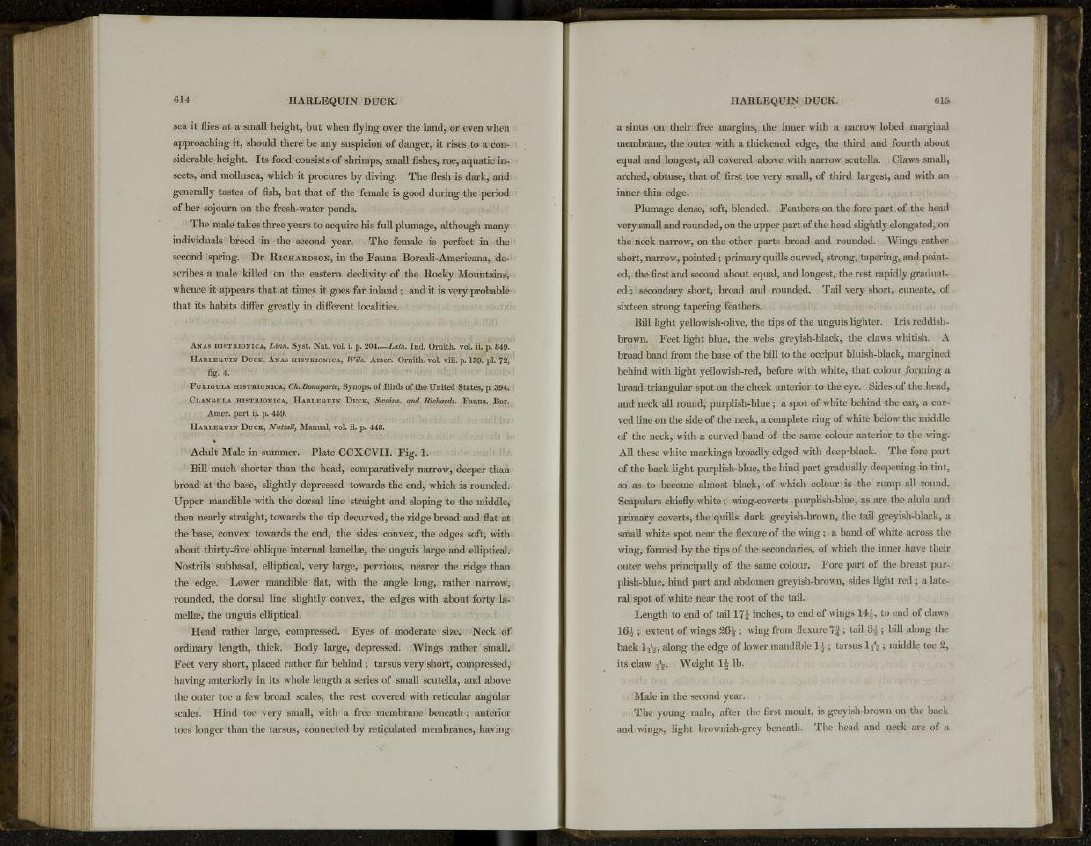
614 HARLEQUIN DUCK.
sea it flies at a small height, but when flying over the land, or even when
approaching it, should there be any suspicion of danger, it rises to a considerable
height. Its food consists of shrimps, small fishes, roe, aquatic insects,
and mollusca, which it procures by diving. The flesh is dark, and
generally tastes of fish, but that of the female is good during the period
of her sojourn on the fresh-water ponds.
The male takes three years to acquire his full plumage, although many
individuals breed in the second year. The female is perfect in the
second spring. Dr RICHARDSON, in the Fauna Boreali-Americana, describes
a male killed on the eastern declivity of the Rocky Mountains,
whence it appears that at times it goes far inland; and it is very probable
that its habits differ greatly in different localities.
ANAS HISTRIONICA, Linn. Syst. Nat. vol. i. p. 204—Lath. Iud. Ornith. vol. ii. p. 849.
HARLEQUIN DUCK, ANAS HISTRIONICA, Wils. Amer. Ornith. vol. viii. p. 139. pi. 72,
fig. 4.
F U L I G U L A HISTRIONICA, Ch. Bonaparte, Synops. of Birds of the United States, p. 394.
CLANGULA HISTRIONICA, HARLEQUIN DUCK, Swains, and Richards. Fauna. Bor.
Amer. part ii. p. 459.
H A R L E Q U I N DUCK, Nuttatt, Manual, vol. ii. p. 448.
Adult Male in summer. Plate CCXCVII. Fig. 1.
Bill much shorter than the head, comparatively narrow, deeper than
broad at the base, slightly depressed towards the end, which is rounded.
Upper mandible with the dorsal line straight and sloping to the middle,
then nearly straight, towards the tip decurved, the ridge broad and flat at
the base, convex towards the end, the sides convex, the edges soft, with
about thirty-five oblique internal lamellse, the unguis large and elliptical.
Nostrils subbasal, elliptical, very large, pervious, nearer the ridge than
the edge. Lower mandible flat, with the angle long, rather narrow,
rounded, the dorsal line slightly convex, the edges with about forty lamellae,
the unguis elliptical.
Head rather large, compressed. Eyes of moderate size. Neck of
ordinary length, thick. Body large, depressed. Wings rather small.
Feet very short, placed rather far behind ; tarsus very short, compressed,
having anteriorly in its whole length a series of small scutella, and above
the outer toe a few broad scales, the rest covered with reticular angular
scales. Hind toe very small, with a free membrane beneath ; anterior
toes longer than the tarsus, connected by reticulated membranes, having
HARLEQUIN DUCK.
a sinus on their free margins, the inner with a narrow lobed marginal
membrane, the outer with a thickened edge, the third and fourth about
equal and longest, all covered above with narrow scutella. Claws small,
arched, obtuse, that of first toe very small, of third largest, and with an
inner thin edge.
Plumage dense, soft, blended. Feathers on the fore part of the head
very small and rounded, on the upper part of the head slightly elongated, on
the neck narrow, on the other parts broad and rounded. Wings rather
short, narrow, pointed; primary quills curved, strong, tapering, and pointed,
the first and second about equal, and longest, the rest rapidly graduated
; secondary short, broad and rounded. Tail very short, cuneate, of
sixteen strong tapering feathers.
Bill light yellowish-olive, the tips of the unguis lighter. Iris reddishbrown.
Feet light blue, the webs greyish-black, the claws whitish. A
broad band from the base of the bill to the occiput bluish-black, margined
behind with light yellowish-red, before with white, that colour forming a
broad triangular spot on the cheek anterior to the eye. Sides of the head,
and neck all round, purplish-blue; a spot of white behind the ear, a curved
line on the side of the neck, a complete ring of white below the middle
of the neck, with a curved band of the same colour anterior to the wing.
All these white markings broadly edged with deep-black. The fore part
of the back light purplish-blue, the hind part gradually deepening in tint,
so as to become almost black, of which colour is the rump all round.
Scapulars chiefly white; wing-coverts purplish-blue, as are the alula and
primary coverts, the quills dark greyish-brown, the tail greyish-black, a
small white spot near the flexure of the wing ; a band of white across the
wing, formed by the tips of the secondaries, of which the inner have their
outer webs principally of the same colour. Fore part of the breast purplish
blue, hind part and abdomen greyish-brown, sides light red ; a lateral
spot of white near the root of the tail.
Length to end of tail 17£ inches, to end of wings 14,1, to end of claws
16£ ; extent of wings 26£ ; wing from flexure 7f; tail 3.^; bill along the
back lt\2, along the edge of lower mandible 1] ; tarsus lft ; middle toe 2,
its claw ft. Weight 1£ lb.
Male in the second year.
The young male, after the first moult, is greyish-brown on the back
and wings, light brownish-grey beneath. The head and neck arc of a